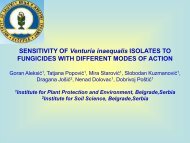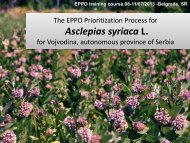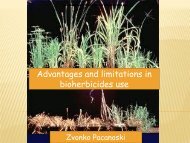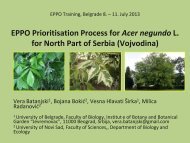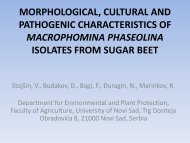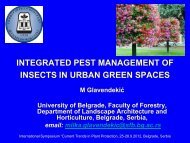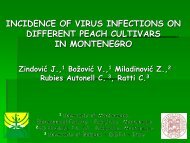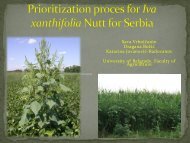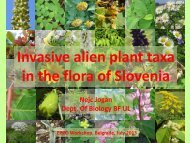kvalitet
Vol.55 - Izbis
Vol.55 - Izbis
- No tags were found...
You also want an ePaper? Increase the reach of your titles
YUMPU automatically turns print PDFs into web optimized ePapers that Google loves.
Uticaj hranljive podloge i temperature na razvoj Apiognomonia veneta 37<br />
The optimum temperatures for colonies growth as well as for fructification<br />
of the anamorph of the fungus studied were 20° and 25°C (Tables 3 and 4).<br />
At 15°C colonies developed but fructification was absent while at 10°C<br />
colonies growth and conidia formation were depending on isolates in questin<br />
because Pl-61 one don't produce them (Tables 3 and 4).<br />
At 5°C colonies growth and fruiting bodies formation were weak but conidia<br />
production were absent.<br />
This also may be explane by differences beetwen plane trees tissue and<br />
substances content in nutrient agar.<br />
However, this data more or less are in accordance with environmental<br />
condition in nature because Cellerino and Anselmi (1978) emphasizes the<br />
temperature ranges from 9°-12°C needs for first buds infections at the sprouting<br />
in spring spreading on young shoots as long as the temperature does not excesed<br />
14°-16°C.<br />
The infections keep on developing on leaves until the average temperature<br />
reaches 18°-20°C and sometimes during the whole spring or further on.<br />
According to these authors the host susceptibility depends on the species of<br />
sycamore are in questin, on the individual plant and physiological conditions of<br />
the plants, on the age of leaves (5-20 days old being most susceptible) and on the<br />
inoculum preasures of the pathogen.<br />
Therefore, conidiomata and conidia production at relativelly higher<br />
temperatures in-vitro it could not be so suprising. Because, the temperature<br />
conditions for plane tissues infections and mycelium growth in the host tissue<br />
represents one question and another is: which temperatures enables the pathogen<br />
fructification in nature ?<br />
At the end different behavior of our four strains of the fungus Apiognomonia<br />
veneta investigated on nutrient media and at the various temperature conditions<br />
indicate on heterogeneous pathogen population which in nature probably exist<br />
(Table 1-4).<br />
Key words: Apiognomonia veneta, plane trees, isolates, nutrient media,<br />
temperature, anamorph, teleomorph, fruiting bodies, conidia.<br />
(Received: 05.02.2007.)<br />
(Accepted: 08.08.2007.)<br />
Plant Protection: Vol. 55 (1-4), No 247-250, 27-37, 2004, Belgrade



